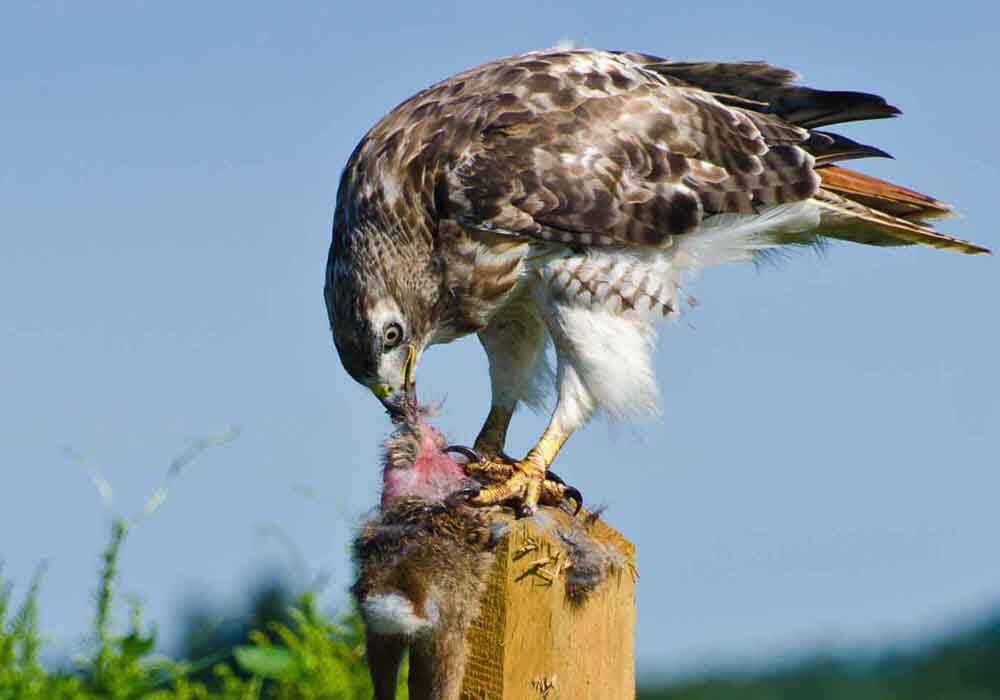Are Hawks Predators
or Scavengers?
Whenever you see a hawk in real life, you just know that these birds are built to be among nature’s mightiest predators. However, is the term “predator” appropriate when it’s common to see hawks feast on carcasses, anyways? Maybe the mighty hawk isn’t so mighty after all. So, are Hawks predators or scavengers?
Hawks are predators that occasionally scavenge. Because hawks are not at all selective with the type of food they eat, they can stomach the meat of dead animals. The extent of scavenging, however, is not the same for all hawks.
In this article, I will discuss factors that lead predator birds, such as hawks, to scavenge. Then I’ll tell you about some fascinating types of hawks prone to scavenging.

Why Some Hawks Scavenge
Hunting for food takes up much of an animal’s energy, and when it comes to predators like the hawk, “fast food” is generally a welcome snack.
Imagine the hawk having to hover over the same area, looking for prey repeatedly. When it finds something to eat, it has to position itself strategically so as not to give itself away, which could take forever!
When it does strike, there isn’t even a guarantee it will hit! The entire process would honestly wear me out.
Luckily, food will sometimes present itself to predators, particularly in the winter. Many small mammals succumb to hypothermia and frostbite at this time because of the decline in the food supply. Carcasses on roads and in clearings don’t go to waste when there’s a hawk nearby.
These deceased animals present predators with the opportunity to sustain themselves with little effort, which is particularly beneficial in winter when food is otherwise scarce. Small mammals aren’t the only ones saving up their energy, after all.
Some bird species have developed a relationship with other predators to find food. For example, hordes of the common raven often follow North American wolves around to feast on the carcasses the wolves would leave behind.
Additionally, we humans present predators with various opportunities to scavenge. Due to electrocution, US power lines kill almost 12 million birds annually. Shocking, isn’t it?
On top of that, more than one billion birds are killed due to road collisions annually worldwide. This high death rate makes it understandable for the hawk to simply eat roadkill and other carcasses. Meat is there for them to gobble up, and why say no to a free buffet?

How safe are my pets when Hawks are around? Should I keep them inside or is it alright for them to be outside? We answer these questions in our informative article Do Hawks Attack Cats and Dogs?
Scavenging Among Common Hawks
Although we can generally say that hawks are inherent predators with some slight scavenging tendencies, some types of hawks scavenge way more than others.
Red-Shouldered Hawk
The red-shouldered hawk, seen mainly in Canada and the Florida Keys, doesn’t seem like a picky eater. This opportunist eats frogs, toads, smaller birds such as doves, and even crayfish. Its favorite, however, appears to be the chipmunk and the meadow vole.
This type of hawk is known for being remarkably adaptive and is no stranger to eating carcasses. As it is known for being incredibly opportunistic, it has been observed eating the bodies of the common nighthawk and other small mammals.
So adaptable is the red-shouldered hawk that it also associates with the American crow to forage in compost piles.
Red-Tailed Hawk
The red-tailed hawk, also seen in Canada, the Eastern United States, and the Florida Keys, seems to follow the same diet as the red-shouldered hawk. It also eats snakes and chicken carcasses discarded from farm fields.
When eating carcasses, the red-tailed hawk occasionally spreads and fluffs its wings to conceal its meal from the competition – a behavior called mantling.
Here’s an example of what mantling looks like:
In the video, you can see that the red-tailed hawks don’t seem to be too concerned with the vultures in the area. Things are shaken up, however, when other hawks arrive.
Swainson’s Hawk
The Swainson’s hawk, which frequents the central United States, primarily eats small insects.
A study documenting Swainson’s hawks discovered that these hawks could devour an average of 100 grasshoppers per day, especially during grasshopper infestations.
During the breeding season, however, Swainson’s hawks switch to a diet of rabbits and rodents.
Because eating small mammals is only secondary to their diet, these hawks don’t scavenge as much as the red-shouldered and red-tailed hawks.
However, they also feast on rabbits shot for recreation or rodents killed by pest control. This scavenging has even led these birds to experience symptoms of lead poisoning, as they sometimes ingest bullets.

When you see a Hawk in your yard, is that a good or bad thing? Many are fearful when seeing this large bird, or can their presence be beneficial? This informative article of ours addresses the pros and cons of having Hawks around.
Northern Goshawk
The Northern goshawk belongs to a group of animals called avivores, which prey primarily on small birds. As such, the Northern goshawk goes after grouses, crows, ducks, and pheasants but also occasionally eats small mammals such as rabbits and squirrels.
Under normal circumstances, the Northern goshawk does not scavenge at all. There have been reports, however, of the bird eating off of a black bear carcass, but these instances continue to be very rare.
Scavenging is more common with other goshawks, such as the gray and brown goshawks, both native to Australia.
Cooper’s Hawk
Much like the Northern goshawk, the Cooper’s hawk’s diet primarily consists of small birds such as jays, robins, and flickers.
This hawk, which can be found soaring around Southern Canada to Northern Mexico, also occasionally eats squirrels and chipmunks.
One of the first recorded instances of Cooper’s hawks feeding off a carcass was in 1994, when an immature hawk consumed a road-killed rabbit.
As of today, Cooper’s hawk is still generally opposed to scavenging.

The nesting habits of Hawks are a fascinating thing. Learn more about them in this indepth article of ours dedicated to just this topic!
Are
Hawks Predators or Scavengers? ...Conclusion
Some types of hawks can stomach carcasses far more easily than other hawks. The tendency to scavenge per type of hawk is still very much determined by the seasonality and availability of carcasses in their hunting grounds. Generally, hawks prefer fresher food but will consume carcasses if there’s nothing better to eat.
However, despite this occasional scavenging, with their sharp beak and talons, the hawk was made to be and should still be deemed a predator first and foremost.
Back To the TOP Of This Are Hawks Predators or Scavengers?
Page

About the Author...
Richard Worden, a dedicated bird lover for over 20 years, I love to share my in-depth knowledge and passion for birds. Read more About Me and my expertise in this field.
- We Know Birds HOME ›
- Hawk Facts and Information ›
- Are Hawks Predators or Scavengers?
